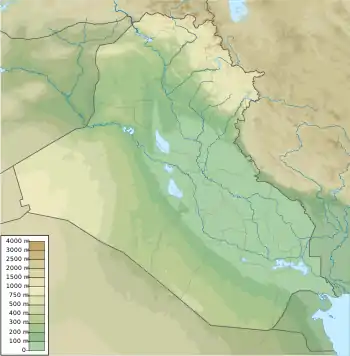Diniktum
Diniktum, inscribed Di-ni-ik-tumKI, was a middle bronze-age town located somewhere in the lower Diyala region of Mesopotamia,[1] on the Tigris river downstream from Upi and close to the northern border of Elam. It is possibly at or in the vicinity of Tell Muḥammad, which lies in south-eastern part of modern Baghdad.[2][3]It is mentioned in the Harmal geographical list.[4]
Diniktum | |
 Shown within Iraq | |
| Location | Baghdad, Baghdad Governorate, Iraq |
|---|---|
| Region | Mesopotamia |
| Coordinates | 33°17′37.0752″N 44°28′58.4112″E |
| Type | tell |
History
It enjoyed independence briefly during the 18th century under the reigns of the Amorite chieftains (ra-bí-an MAR.DÚ) Itur-šarrum,[3] attested on a single seal from Ešnunna, and Sîn-gāmil, son of Sîn-šēmi and a contemporary of Zimri-Lim (ca. 1710–1698 BC short) of Mari and Ḫammu-rapī (ca. 1728–1686 BC short) of Babylon.[5] In an old Babylonian letter from Yarim-Lim I, the king of Yamḫad to the Yašub-Yahad, the king of Dēr,[6][7][8] he says:
.. Certainly. Sîn-gāmil, king of Diniktum. very much like you would repeatedly respond to me by means of lies and provocations. Having docked 500 boats in Diniktum's quay. I "sank" (supported?) his land as well as him for 12 year!"[9]
— Iarīm-Līm, Tablet A. 1314, Letter to Yašub-Yahad
Yarim-Lim I would defeat the king of Diniktum in battle.[10]
One king of Diniktum named Itur-šarrum ruled Diniktum for around a century before his successor Sîn-gāmil became the new ruler of the kingdom.[11]
Ikūn-pî-Sîn (“The word of Sin is truthful”), the ruler of Nērebtum and possibly Tutub, cities in the sphere of Ešnunna, has a year name: “Year when Ikū(n)-pî-Sîn captured Diniktum."[12] It was absorbed into the kingdom of Ešnunna and consequently embroiled in its conflicts with Elam during the reigns of Ibāl-pî-El II (ca. 1715–1701 BC short) and Ṣillī-Sîn (ca. 1700–1698 BC short).[13] During an Elamite invasion of Mesopotamia the Elamites sacked Eshnunna. This caused many soldiers in the Elamite army that were from Eshnunna to defect. Because of the mass desertion, the Elamite king retreated back to Diniktum. While in Diniktum, the Elamites would sue for peace with Hammurabi. The Elamites were than driven from the city.[14]
The town was still settled in the later bronze-age, as a year name gives ““the year [in which] Kadašman-Ḫarbe, the king, dug the canal of Diniktum.”[15] Kadašman-Ḫarbe was a Kassite king of Babylon of the late 15th century.
References
- Frayne, Douglas (1990). Old Babylonian Period. Toronto: University of Toronto Press.
- Paolo Gentili, Where is Diniktum? : Remarks on the Situation and a Supposition, Rivista degli studi orientali, Nuova Serie, Vol. 79, Fasc. 1/4, pp. 231-238, 2006
- Bryce, Trevor (2009). The Routledge Handbook of The Peoples and Places of Ancient Western Asia: From the Early Bronze Age to the Fall of the Persian Empire. Routledge. ISBN 978-041-539-485-7.
- Tablet IM 51143.
- Douglas Frayne (1990). Old Babylonian period (2003-1595 BC): Early Periods, Volume 4 (RIM The Royal Inscriptions of Mesopotamia). University of Toronto Press. pp. 682–685.
- Charpin, Dominique (2010). Writing, Law, and Kingship In Old Babylonian Mesopotamia. United States of America: University of Chicago Press. ISBN 978-022-610-159-0.
- Weiss, Harvey (1985). Ebla to Damascus: Art and Archaeology of Ancient Syria : an Exhibition from the Directorate General of Antiquities and Museums of the Syrian Arab Republic. Baltimore: Smithsonian Institution Traveling Exhibition Service.
- Sasson, Jack (1995). Civilizations of the Ancient Near East: Volume 2.
- J. Sasson (1985). "Yarim-Lim's War Declaration". Editions Recherche sur Ies Civilisations. Paris. p. 244.
- Wu, Yuhong (1994). A Political History of Eshnunna, Mari and Assyria During the Early Old Babylonian Period: From the End of Ur III to the Death of Šamši-Adad. Institute of History of Ancient Civilizations, Northeast Normal University.
- Seri, Andrea (2003). Local Power: Structure and Function of Community Institutions of Authority in the Old Babylonian Period. University of Michigan. ISBN 978-049-643-819-8.
- Journal of Cuneiform Studies: Volumes 9-11. American Schools of Oriental Research. 1955.
- Trevor Bryce (2009). The Routledge Handbook of The People and Places of Ancient Western Asia. Routledge. p. 196.
- Van De Mieroop, Marc (2008). King Hammurabi of Babylon: A Biography. Wiley. ISBN 978-047-069-534-0.
- Tablet Ni. 3199.